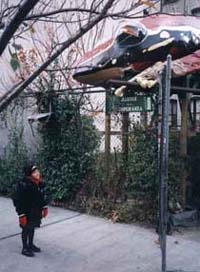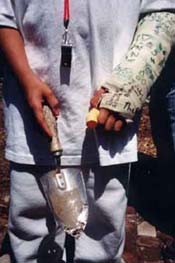
 |
 |
 |
 |
 |
 |
 |
|
On February 15, 2000 Esperanza Garden was bulldozed by the city, but not without a massive protest and lockdown by gardeners and other members of the community. The article below was written prior to the bulldozing. |  El Jardin de la Esperanza is in imminent danger. The Garden of Hope rose from the ashes of a burnt-out building over 22 years ago in a neighborhood plagued by landlord neglect. Alicia Torres, with the help of her family and neighbors, worked for months clearing the rubble and debris to make room on the scarred Earth to plant sunflowers and roses. The land was reborn. After three generations of sweat, labor and healing, the garden is rich with the bounties of the Earth. Roses as tall as trees bloom until late December; medicinal plants are nurtured by neighbors to make healing teas; kids come off the street to play hide and seek behind the tool shed, while others finish their homework under the casita built by Alicia's son, Moses. A rooster crows just before dawn. Puerto Rican culture is integrated into the life of the Lower East Side with a rich history of struggle and growth.
In the interior of the Coqui, activists next to a pair of concrete encased "black bears" look out 10 feet up over Esperanza's fence, into the street. Beneath them, protecting the front gate, rests a "sleeping dragon." Both devices are for activists to lock themselves to in the event of an attack by bulldozers. Soon after the Coqui was completed the wall behind the garden was torn down with a huge crane and bulldozer which then parked inches away from the Garden of Hope. Esperanza responded (with help from local welders and engineers) by constructing a high tower in the shape of a beautiful sunflower. Seeded amidst the petals, 26 feet above the ground, is a chair where a garden defender can lock down. Two more sleeping dragons and a tripod are now planted in the back of the garden. Amongst the plants dormant in the cold of winter is a full time encampment, with tents, a kitchen and bonfire to keep the bustling people warm. Alicia Torres, who just turned 76, talks to the plants and prays to them. She also prays for the prospective developer, Donald Capoccia, so that the Creator will open up his heart and change his plans on destroying the community garden. Capoccia's plans for this neighborhood are quick profits from luxury apartments, while destroying the long-term efforts of residents to create spaces for communities and for the Earth to flourish. Two years ago, during winter, he destroyed Chico Mendez Mural Garden, The Angels' Garden, Little Puerto Rico Garden and Maria's Garden (all deemed "vacant lots" in the Housing Preservation and Development (HPD) register, just few blocks away. These gardens were turned into government subsidized condos for high-income tenants. Since 1992, Capoccia's firm has received over $20 million in construction contracts from HPD. NYC Mayor Rudolph Giuliani has been instrumental in the wholesale destruction of community gardens and spaces in favor of speculative real estate interests funding his political machine. Most of the city council has also disregarded public demands that community gardens be made permanent. Capoccia got the Esperanza garden after a deal with a local councilwoman, Margarita Lopez, for "80-20" housing, meaning that that 80 percent of the dwellings are rented at full market value which runs up to $3,000 per bedroom. The other 20 percent is reserved for "low-income" tenants; though after 10 years those spaces are then rented at full market value. The 80-20 equation allows developers to receive millions in subsidies, tax exempt bonds and loans from the city. Thus the mayor and council members help this developer to destroy all of Esperanza and much of El Jardin Bello Amanecer Borinqueno (Beautiful Puerto Rican Dawn) without any benefits to the majority of those who have voted for them. At present, Capoccia's construction company has an open case from the Department of Labor for violations of fair labor standards. The company is notorious for unfair labor practices, denying positions to unionized workers, creating unsafe work sites and authorizing shoddy construction; his building practices have three times sent cracks through adjacent buildings, compromising their structural integrity and endangering inhabitants. More Gardens! advocates a long-term strategy to make all community gardens into permanent public parklands. At present, the most promising avenue is the Sampson's Bill, a piece of legislation in the New York State Senate. The city must first pass a resolution to allow the bill to be considered at the Senate level. An integral part of preserving threatened gardens in the short term is garnering the support of our environmentally friendly State Attorney General Elliot Spitzer. He has the power to call for an injunction against the destruction of community gardens that are now in danger.
Alicia, born on the island of Vieques said, "We have to save Esperanza for the children, for everyone!" Today, instead of deterioration and neglect, community gardeners, people and activists join in to protect our sacred green space from a larger danger of fast pace, quick money, short term consumer developers and politicians. Each petal of the huge sunflower towering above Esperanza reads, "Esperanza/Hope, Lindo/Beauty, Communidad/Community, Oxygeno/Oxygen, Comida/Food"--the gifts of the Earth. Here we draw our line. Join the turning of the tide! |
 At El Jardin de la Esperanza, on East 7th street and Avenue C in Manhattan's
Lower East Side, Esperanza gardeners, the More Gardens! Coalition and many other
activist supporters have bonded together to create a grassroots community of
resistance. At the front gate of Esperanza they have erected a giant sculpture in
the shape of a coqui. The coqui is a thumb-sized frog which is the national
symbol of Puerto Rico. In one myth a monster approaches the forest and intends to
destroy it. The coqui steps up and is able to scare away the monster with the
loudness of its voice, an apt analogy for community gardeners facing bulldozers.
At El Jardin de la Esperanza, on East 7th street and Avenue C in Manhattan's
Lower East Side, Esperanza gardeners, the More Gardens! Coalition and many other
activist supporters have bonded together to create a grassroots community of
resistance. At the front gate of Esperanza they have erected a giant sculpture in
the shape of a coqui. The coqui is a thumb-sized frog which is the national
symbol of Puerto Rico. In one myth a monster approaches the forest and intends to
destroy it. The coqui steps up and is able to scare away the monster with the
loudness of its voice, an apt analogy for community gardeners facing bulldozers.
 Unhindered by the failings of "urban renewal," gardeners have begun a renewal
of the Earth in the concrete and congestion of New York, returning land to the
hard working hands of dedicated people and nature. The re-greening of the urban
landscape is underway. The city's community gardens host migrating ruby-throated
hummingbirds and monarch butterflies as well as bumble bees, squirrels and hosts
of soil sustaining insects. New York City has seen a return of peregrine falcons,
red tail hawks, great blue heron and even coyotes. This is a fragmented ecosystem
beginning to heal. More Gardens! Coalition promotes the development and
preservation of the community gardens. They are committed to revitalizing and
enhancing existing community gardens and cultivating fallow land in our city.
Unhindered by the failings of "urban renewal," gardeners have begun a renewal
of the Earth in the concrete and congestion of New York, returning land to the
hard working hands of dedicated people and nature. The re-greening of the urban
landscape is underway. The city's community gardens host migrating ruby-throated
hummingbirds and monarch butterflies as well as bumble bees, squirrels and hosts
of soil sustaining insects. New York City has seen a return of peregrine falcons,
red tail hawks, great blue heron and even coyotes. This is a fragmented ecosystem
beginning to heal. More Gardens! Coalition promotes the development and
preservation of the community gardens. They are committed to revitalizing and
enhancing existing community gardens and cultivating fallow land in our city.